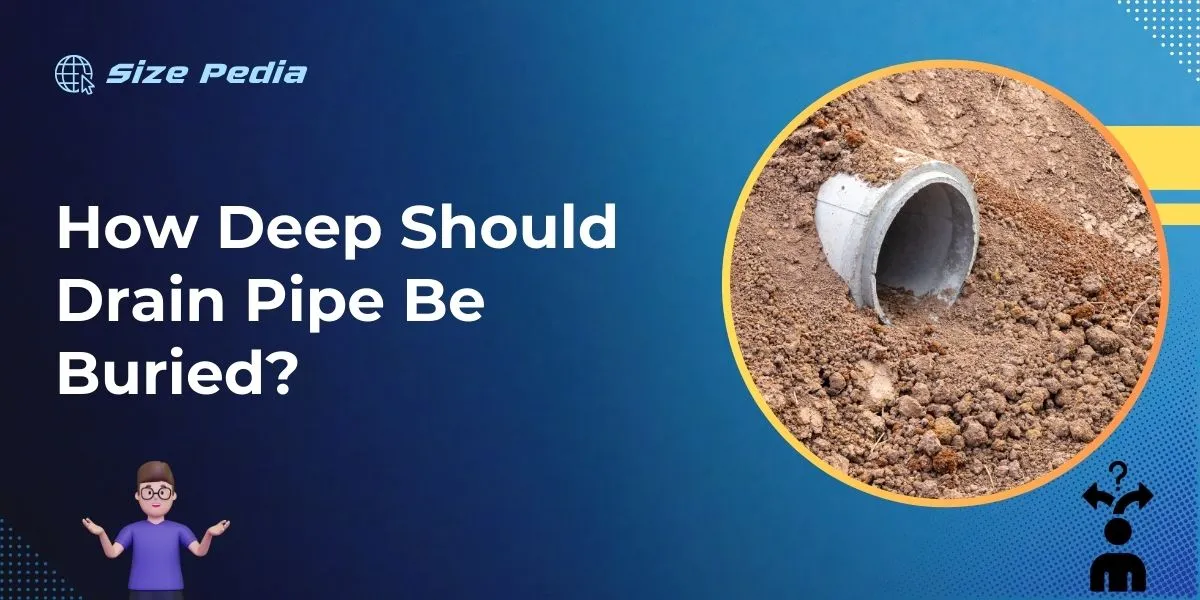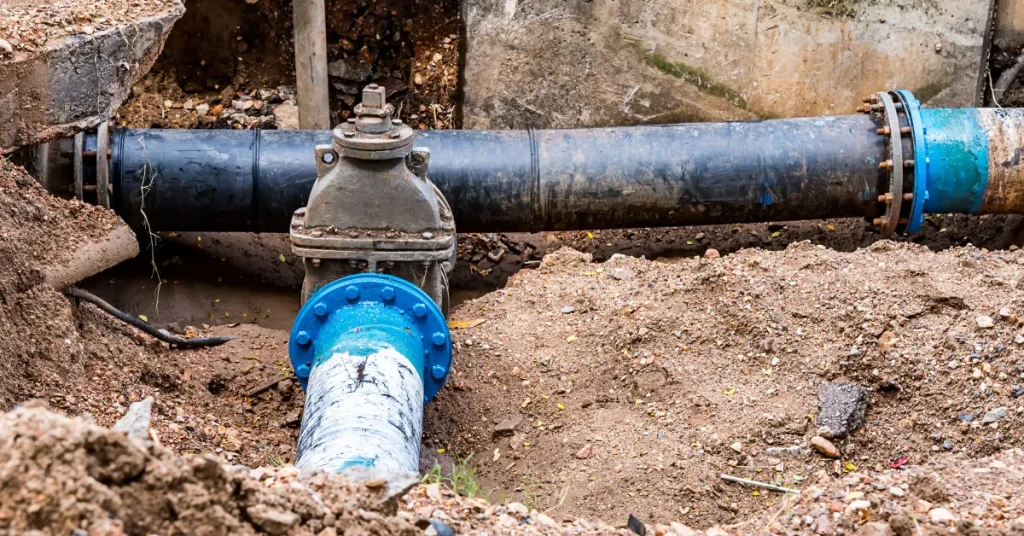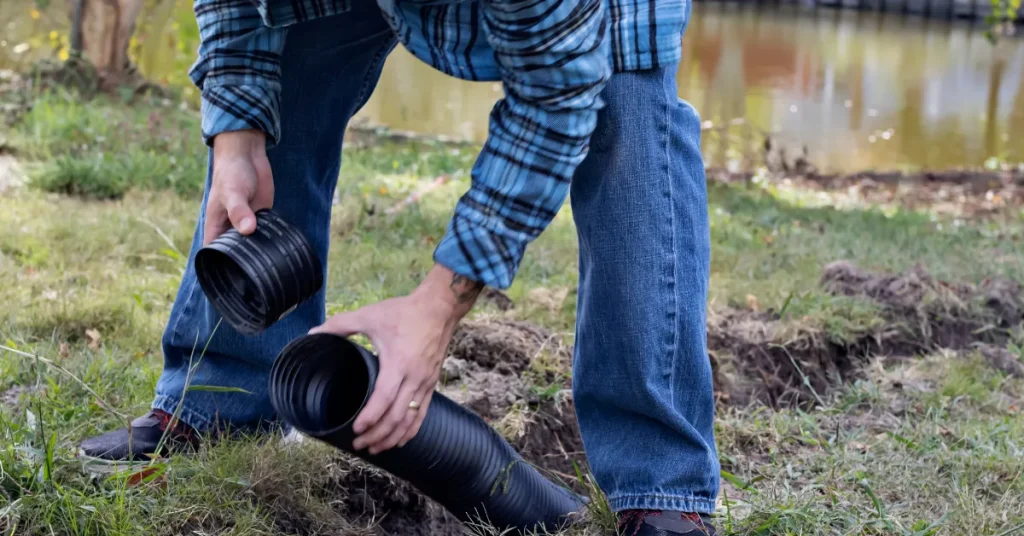Drain pipes must typically be buried at least 12 to 24 inches below the surface. Frost lines, load-bearing requirements, and local codes dictate the exact depth.
Ensuring proper drainage around your home or business is critical. The right depth for a drain pipe is not a one-size-fits-all scenario; various factors must be considered.
Climate plays a significant role, as regions with colder temperatures require deeper burial to prevent freezing.
Adhering to local building codes is equally important, as they can influence how deep you should bury your pipe to comply with safety standards.
A well-planned drainage system prevents water buildup, which can lead to foundation damage, soil erosion, and unwanted water logging.
By considering these elements, you’ll maintain the integrity of your landscape and infrastructure. Choosing the correct depth for your drain pipe installation is crucial for the long-term efficacy of your drainage solution.

Factors Influencing Drain Pipe Depth
Deciding on the right depth to bury a drain pipe is crucial for its effectiveness and longevity. Several factors come into play when determining the appropriate depth.
Understanding these can lead to more efficient drainage systems. Ignoring them might result in costly repairs. Let’s delve into the key factors.
Soil Type And Drainage Characteristics
The type of soil in your area greatly affects your drain pipe depth. Sandy soils with good drainage might not require pipes to be buried too deep. On the other hand, clay soils with low permeability could mean deeper installations. Here’s a quick view:
- Sandy soils: Better draining, shallower depths may work.
- Clay soils: Poor draining, consider deeper burial.
Drainage patterns and the presence of bedrock can also influence depth.
Climate And Freeze Depth
Your local climate plays a large part in how deep you should bury your drain pipe. If the ground freezes, your pipe should be below the frost line. This prevents freezing and cracking. Here’s how climate affects depth:
| Climate Type | Recommended Depth |
| Cold with freezing winters | Below frost line (check local code) |
| Mild, minimal frost | 12-18 inches or per local code |
Refer to local building codes for specific depth requirements in your area.
Regulatory Guidelines For Pipe Burial
Understanding the Regulatory Guidelines for Pipe Burial is critical for any construction or renovation project. Specific depth requirements ensure the longevity and proper functioning of your drainage system.
Regulatory adherence is not only about following the law. It’s also about safety, functionality, and maintaining accessibility for future maintenance.
Building Codes And Standards
Building codes and standards dictate the depth at which drain pipes should be buried. These can vary based on location and the type of pipe in use. Here are the key points:
- Regional variations: Check the local building codes for specific depth requirements.
- Type of pipe: Material and diameter can influence burial depth.
- Zoning laws: Impact the installation of underground utilities.
| Area | Minimum Depth (Inches) |
| Non-traffic areas | 12″ |
| Traffic areas | 18″ |
| Frost line depth | Varies |
Safety And Accessibility Considerations
Safety is paramount when burying drain pipes. Neglecting proper depth can lead to pipe damage or safety hazards. Here’s why depth matters:
- Pipes need to be deep enough to avoid accidental damage from above-ground activities.
- Insufficient burial can cause pipes to freeze in cold climates, leading to bursts.
Accessibility is critical for repairs or upgrades. Consider these accessibility guidelines:
- Ensure the depth allows for future access to pipes, without compromising structural integrity of the surface above.
- Document pipe locations and depths to aid in this process.
Whether for new construction or upgrades, always adhere to the appropriate depth guidelines. Consulting with a professional can also provide personalized insight.
Types Of Drain Pipes And Depth Requirements

Choosing the right depth for burying your drain pipe is critical. It ensures the system works well and lasts long. Pipe type and soil condition affect how deep you should bury your pipes.
Follow local building codes to know the exact depth requirements. Now let’s compare pipe types and their ideal burial depths.
Corrugated Vs. Pvc: A Comparison
Burial depths can differ greatly based on whether you select corrugated or PVC pipes. These popular materials have unique strengths and installation needs.
- Corrugated pipes are flexible and can contour to the landscape. They are perfect for areas with soft soil.
- PVC pipes, on the other hand, are rigid and durable. They are well-suited for high-traffic areas and heavy-load environments.
PVC usually requires a deeper trench compared to corrugated options. That’s because it’s more prone to damage if not protected enough by soil. A professional’s assessment is vital for a safe installation.
Impact Of Pipe Diameter On Burial Depth
The diameter of your drain pipe also influences how deep it should go. Larger pipes will need a deeper trench.
| Diameter | Minimum Depth |
| 4 inches | 12 inches |
| 6 inches | 18 inches |
| 8 inches and above | 24 inches |
The above table shows general guidelines. Your soil type can change these numbers. For example: clay soil requires more depth, while sandy soil needs less.
Always consider frost lines and vehicle pressure as well. Freeze-thaw cycles can damage shallow pipes. Heavy vehicles can crush pipes not buried deeply enough.
Installation Best Practices
Installation Best Practices for underground drain pipes are vital for long-lasting and efficient drainage systems.
Adhering to specific depths and implementing precise trenching and sloping techniques ensure that your drainage system is effective and durable.
Let’s delve into the details of proper installation to safeguard your property’s foundation and landscaping.
Trenching Techniques
Correct trenching creates a stable base for your drainage pipes. Consider these key points:
- Mark the layout – Use flags or spray paint to outline the trench path.
- Choose the right tools – A spade or a trenching shovel works for small projects, while a trencher is best for larger areas.
- Maintain uniform width and depth – This prevents sagging and ensures consistent flow.
- Check for utilities – Always call 811 before digging to avoid damaging underground lines.
Ensuring Proper Slope
To guarantee water flows away from your foundation, setting the correct slope for your drain pipe is crucial:
| Pipe Diameter | Minimum Slope | Optimal Slope |
| 4 inches | 1/8 inch per foot | 1/4 inch per foot |
| 6 inches | 1/8 inch per foot | 3/8 inch per foot |
Follow these steps to ensure the slope is correct:
- Use a leveler or laser transit to define the slope.
- Adjust the trench depth accordingly to maintain the proper angle.
- Verify the slope regularly as you lay the pipe to prevent backflow.
Stringent adherence to these practices will lead to an exemplary drainage system that protects your property.
Common Challenges And Solutions
Understanding the right depth for burying drain pipes can be tricky. It often involves overcoming common challenges that vary by location and soil type. Nevertheless, solutions are available to address these issues effectively.
They ensure that drainage systems function optimally, last longer, and comply with regulations.
Dealing With High Water Table
A high water table can affect the depth at which drain pipes should be laid. Pipes need to be below frost lines but above water-saturated soils. Here are steps to manage this challenge:
- Conduct soil testing to identify the water table level.
- Use watertight pipes to prevent infiltration
- Consider a pumped system if gravity drainage isn’t possible.
- Install a sump pump to deal with excess water.
Preventing Pipe Collapse And Frost Heave
Pipe collapse and frost heave can damage your drainage system. Avoid these problems with the following measures:
| Problem | Solution |
| Pipe Collapse | Use sturdy pipes and compact the soil around them. |
| Frost Heave | Bury pipes below the frost line and use insulation. |
Maintenance And Upkeep Of Buried Drain Pipes

Maintenance and upkeep are vital for ensuring buried drain pipes function properly long-term. Neglecting this aspect can lead to costly repairs and inefficient drainage systems.
Proper care includes routine inspections and consistent long-term strategies to ensure the integrity and functionality of your drain pipes.
Routine Inspection Tips
- Check for visible signs of damage or wear annually.
- Monitor for changes in water flow or unusual wet spots in the yard, which could indicate leaks.
- Use a plumber’s snake or camera for internal inspections to identify potential blockages or damage within the pipes.
- Maintain clear records of inspections to track changes over time.
Long-term Care Strategies
- Ensure surrounding soil is stable and not prone to shifting, which could damage pipes.
- Include the installation of cleanouts for easier access and maintenance.
- Implement regular cleanings to prevent buildup that can lead to blockages.
- Consider the use of root inhibitors near pipes to prevent tree root intrusions.
- Replace any parts with corrosion or significant wear as needed.
FAQs About How Deep Should Drain Pipe Be Buried
What Is The Standard Depth For Drain Pipes?
The standard depth for burying drain pipes is typically between 12 to 18 inches. This depth protects pipes from damage due to traffic, weather, or root intrusion.
How Deep Should Sewer Lines Be Buried?
Sewer lines should usually be buried at least 24 to 30 inches deep. Local building codes may dictate the exact depth to ensure they are below the frost line and safe from external pressures.
Does Pipe Size Affect Burial Depth?
Yes, pipe size influences burial depth. Larger pipes may require deeper trenches to ensure proper slope and flow, while smaller ones might need less depth. Always follow local regulations for specific requirements.
Can Drain Pipes Be Too Deep?
Draining efficiency decreases if pipes are too deep, leading to potential blockages and complications. It’s important to balance protection with functionality to maintain an effective drainage system.
Conclusion
Burying drain pipes at the correct depth ensures longevity and function. The specifics vary with climate, soil type, and local regulations. Consult professionals when necessary, and always prioritize safety.
Proper installation depth maintains infrastructure and prevents costly repairs. Remember, a well-laid pipe is an investment in your property’s future.
Resources:
1. https://basc.pnnl.gov/resource-guides/gutters-and-downspouts
